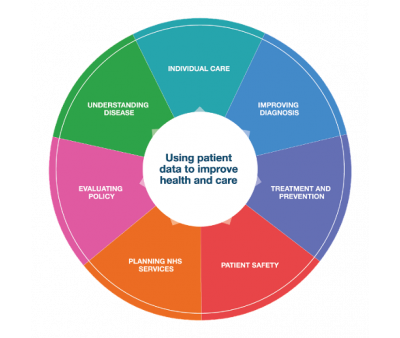Data can help to demonstrate physiotherapy’s impact when it is properly collected and analysed

What is ‘meaningful data’?

We routinely gather all manner of data about the patients and populations we serve. This data comes from many sources, including patient satisfaction surveys, Patient Reported Outcome Measures (PROMs) and length-of-stay metrics. The data is gathered for a variety of purposes, as illustrated.
Presenting data (objective facts) alongside the story or narrative behind that data can be powerful in showing the quality of our work to colleagues – as a first step in developing new research or securing funding, or to develop new services.
For data to be considered ‘meaningful’, we need to consider the overall aim and intended purpose of analysing and sharing the data, and the target audience. Examples include:
- A physiotherapist assessing the impact of their care on a patient.
- A team lead physiotherapist analysing data as part of an audit process to improve standards of care.
- A head of service presenting data as part of a business case to commissioners or trust executives.
- A research therapist assessing the impact of an intervention as part of a trial.
Why is meaningful data important?
Data objectively demonstrates the outcome of the work we do and how it affects patients. When combined with the narrative or story, data illustrates the impact physiotherapy makes in the real world – which is pivotal to any quality improvement initiative.
Data has been described as the ‘oil of the future’ because of its importance and high value. A blog from the Health Foundation unpicks this concept further.
When considering ‘meaningful’ use of data, it is helpful to start with this in mind before collecting data, rather than collecting it for data’s sake. Ask what this will demonstrate regarding impact. What will it mean for patients or service provision?
Meaningful use of data is also important in the wider health and care ecosystem, and is fundamental to planning services, researching new and existing treatments and, ultimately, saving lives.
Although no longer operational, the Farr Institute, a research collaboration of academic and health institutions that operated from 2013 to 2018, supported the use of ‘big data’ in improving health and care outcomes. The hashtag #datasaveslives has helped to highlight to the public as well as professionals the importance of using meaningful ‘big data’. This is also illustrated in this animated video.
Examples of meaningful data
These examples show where physiotherapists have used data in a meaningful way to describe their impact, to learn and to improve patient care:
- A team audit in the functional neurological disorder team showed there were more tasks than staff able to complete them. By analysing the meaningful data collected, the team demonstrated that more staff were needed, and further posts were funded as a result.
- A student project on a shoulder rehabilitation class completed a literature review and analysed the data collected by the physios. It showed that the data gathered using the QuickDash outcome measure was not sensitive enough to detect benefits to the patients – the data was not meaningful in this population. The service changed to using the SPADI outcome measure and was able to show improvements in disability from attending the class.
- At a population level, we know that only about 20 per cent of health outcomes are attributable to healthcare input, and that approximately 15 per cent of GP appointments are considered to be for social rather than clinical needs. A new approach called Population Health Management is encouraging clinical teams, commissioners and business intelligence specialists to jointly analyse data at population level to gain insights that might help support more personalised care delivery. There are some touching stories about how population data (including clinical and other council data such as wheelie-bin collection data!) helped to identify people in need in Blackpool and Chorley.
- At a national level, data is collected and used for benchmarking purposes and to reduce unwarranted variation in care. Good examples of this across various disciplines and specialties can be found at Rightcare and Getting it Right First Time. As a physiotherapist, what is important here is understanding that your contributions towards patient care, shown through data, are included in national programmes and that these programmes identify improvement opportunities as well as ‘what good looks like’.
What should I do next?
- Think about where to start. Consider any audit programmes or projects underway in your team or organisation that use meaningful data and where you could get involved.
- What are you passionate about? Start there! Think about ideas for an audit or project where you feel passionately about patient care, treatments or outcomes. Select carefully and work with your team to use data in a way that describes the impact.
- It does not need to be a big project. Understanding your own impact as a clinician, through the use of data on patient experience, clinically effective care or patient safety is essential. If it feels too big, start by using data more in your own practice. Review, reflect, learn and do it again.
- Use existing approaches. Explore tried-and-tested methods for quality improvement or continuous quality improvement when analysing your data. This will help you avoid getting lost in the weeds. Follow a methodology for turning that data (facts) into an understanding of the story (narrative). This in turn leads to the ability to highlight evidence quality or identify areas for improvement or focus. There are some examples below.
- Get friendly with other teams' data geeks. Get to know your business intelligence, informatics and audit teams – they have strong skills that align with your expertise as a clinician and can help work with you on projects. Be friendly, open and curious about your colleagues’ skills for using meaningful data. This includes using physiotherapy peers in the CSP’s Digital and Informatics Group (DIPG) as a support network.
- Find networks and communities to share, learn and grow. The DIPG is a go-to place for all things physiotherapy and data. If you are passionate about quality improvement, the Q Community is also a rich community network for healthcare quality improvement. There is an allied health professions network hosted on the Q community website.
Further information
If you would like to learn more, here are some resources that DIPG members have used in their work:
- Coursera: Make Data Meaningful: Best Practice for the Communication of Health Data.
- Institute for Healthcare Improvement: 5 Tips for Making Good Use of Patient Data Experience.
- Health Foundation: Untapped Potential: Investing in Health and Care Data Analytics.
- King’s Fund: Technology and Data.
- NHS Digital: Data Quality Resources for Clinicians.
- NHS Improvement: Making Data Count.
- NHS Improvement: Plan, Do, Study, Act (PDSA) Cycles and the Model for Improvement.
- Spiegelhalter D: The Art of Statistics. Learning from Data.
Authors:
- Aimee Robson
- Marie Byrne
- Adele Hill
- Linda Vernon
Edited by Daniel Allen

